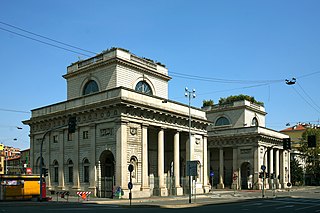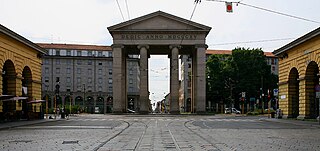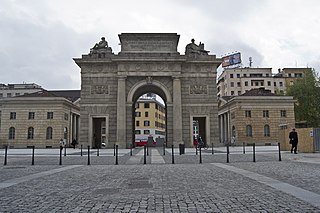Porta Monforte | |
|---|---|
Quartiere of Milan | |
| Country | |
| Region | Lombardy |
| Province | Milan |
| Comune | Milan |
| Zone | 3 |
| Time zone | UTC+1 (CET) |
| • Summer (DST) | UTC+2 (CEST) |
Porta Monforte is a district ("quartiere") of Milan, Italy, located within the Zone 3 administrative division. It is named after the eponymous city gate, which was added in the 1890s to the existing Spanish walls of the city. The gate was meant to serve as a customs office; the tax booths were designed by Luigi Tormenti and completed in 1889. [1] While the addition of the Monforte city gate was intended to absorb part of the traffic going through Porta Venezia and Porta Vittoria, Porta Monforte remained a minor gate. The gate itself has since been demolished; it was located in what is now Piazza del Tricolore ("Tricolour Square"). [2]
A quartiere is a territorial subdivision of certain Italian towns. The word derives from quarto, or fourth, and was thus properly used only for towns divided into four neighborhoods by the two main roads. It has been later used as a synonymous of neighbourhood, and an Italian town can be now subdivided into a greater number of quartieri. The Swiss town of Lugano is subdivided into quarters also.

Milan is a city in northern Italy, capital of Lombardy, and the second-most populous city in Italy after Rome, with the city proper having a population of 1,395,274 while its metropolitan city has a population of 3,259,835. Its continuously built-up urban area has a population estimated to be about 5,270,000 over 1,891 square kilometres. The wider Milan metropolitan area, known as Greater Milan, is a polycentric metropolitan region that extends over central Lombardy and eastern Piedmont and which counts an estimated total population of 7.5 million, making it by far the largest metropolitan area in Italy and the 54th largest in the world. Milan served as capital of the Western Roman Empire from 286 to 402 and the Duchy of Milan during the medieval period and early modern age.

Italy, officially the Italian Republic, is a European country consisting of a peninsula delimited by the Alps and surrounded by several islands. Italy is located in Southern Europe, and it is sometimes considered as part of Western Europe. The country covers a total area of 301,340 km2 (116,350 sq mi) and shares land borders with France, Switzerland, Austria, Slovenia, and the enclaved microstates of Vatican City and San Marino. Italy has a territorial exclave in Switzerland (Campione) and a maritime exclave in the Tunisian Sea (Lampedusa). With around 60 million inhabitants, Italy is the fourth-most populous member state of the European Union.
Porta Monforte was the scene of some of the most dramatic events in the Milan riots of 1898, when the Italian army's artillery bombed a local monastery, killing hundreds of beggars that were standing in line to receive assistance and food. [3]

The Bava Beccaris massacre, named after the Italian General Fiorenzo Bava Beccaris, was the repression of widespread food riots in Milan, Italy, on 6–10 May 1898. In Italy the suppression of these demonstrations is also known as Fatti di Maggio or I moti di Milano del 1898. At least 80 demonstrators were killed, as well as two soldiers, and 450 wounded, according to government sources.

Artillery is a class of heavy military ranged weapons built to launch munitions far beyond the range and power of infantry's small arms. Early artillery development focused on the ability to breach defensive walls and fortifications during sieges, and led to heavy, fairly immobile siege engines. As technology improved, lighter, more mobile field artillery cannons developed for battlefield use. This development continues today; modern self-propelled artillery vehicles are highly mobile weapons of great versatility providing the large share of an army's total firepower.












